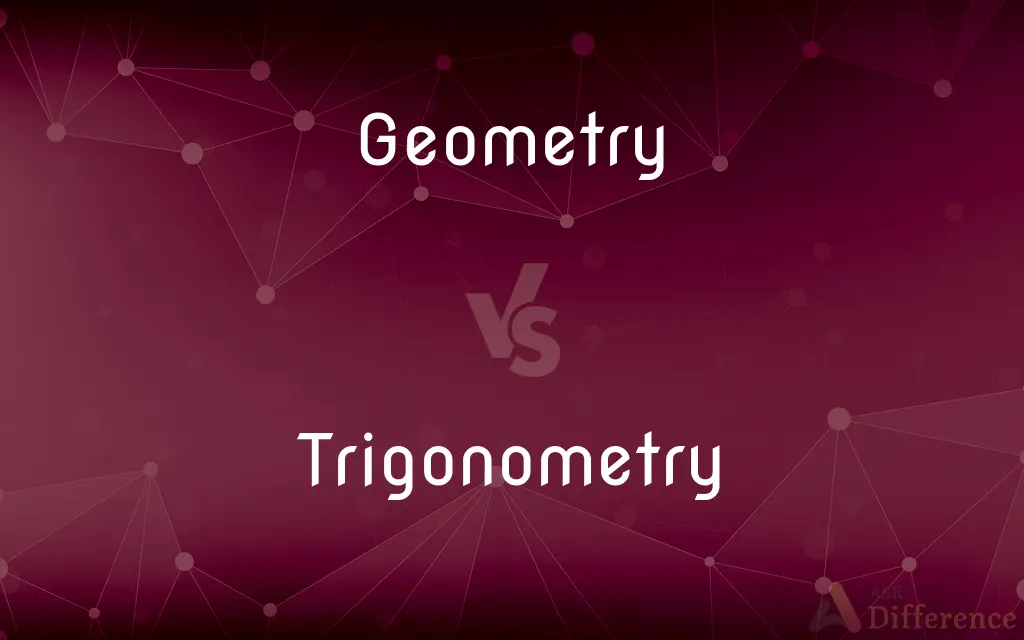Geometry vs. Trigonometry — What's the Difference?
By Urooj Arif & Fiza Rafique — Updated on April 22, 2024
Geometry focuses on shapes, sizes, and the properties of space; trigonometry deals with angles and sides of triangles and their relationships.

Difference Between Geometry and Trigonometry
Table of Contents
ADVERTISEMENT
Key Differences
Geometry is the branch of mathematics concerned with the properties and relations of points, lines, surfaces, and solids, while trigonometry specifically focuses on the study of triangles, particularly the relationships between their angles and sides.
In geometry, calculations often involve understanding the dimensions and transformations of objects in space, whereas trigonometry uses functions like sine, cosine, and tangent to relate the angles of a triangle to its side lengths.
Geometric principles are applied in various fields such as architecture and engineering to design physical structures, on the other hand, trigonometry is crucial in fields like astronomy and navigation for calculating positions and distances.
The study of geometry can begin from a very basic level in elementary education, introducing concepts like shapes and area, while trigonometry is generally introduced at a higher educational level, requiring a foundational understanding of algebra.
Geometry often requires spatial reasoning and visualisation skills to solve problems, whereas trigonometry frequently involves more abstract mathematical calculations and the application of formulas.
ADVERTISEMENT
Comparison Chart
Focus
Shapes, sizes, properties of space.
Relationships of angles and sides in triangles.
Primary Functions/Tools
Compass, ruler, formulas for area and volume.
Sine, cosine, tangent, angle formulas.
Applications
Architecture, art, engineering.
Physics, astronomy, engineering, navigation.
Educational Introduction
Early schooling, basic concepts of space and shapes.
Typically introduced after algebra, in high school.
Skills Required
Spatial reasoning, visualization.
Abstract reasoning, algebraic manipulation.
Compare with Definitions
Geometry
Uses tools like compasses and rulers for construction.
A compass is used in geometry to draw perfect circles.
Trigonometry
The study of triangles and the relationships between their sides and angles.
Trigonometry is essential in determining the height of a mountain.
Geometry
Involves measuring dimensions such as length, area, and volume.
Geometry helps in designing house plans with accurate dimensions.
Trigonometry
Uses functions like sine, cosine, and tangent.
Trigonometry involves calculating the sine of an angle for certain applications.
Geometry
Applies to both two-dimensional and three-dimensional forms.
Geometry can describe the volume of a cube or the area of a square.
Trigonometry
Crucial for solving problems in astronomy and navigation.
Trigonometry was historically developed for navigating the seas.
Geometry
The study of the physical properties of shapes and space.
Geometry is used to calculate the area of a room.
Trigonometry
Requires understanding of unit circles and radians.
The cosine of 0 degrees is 1, which is a basic concept in trigonometry.
Geometry
Based on axioms and theorems.
The Pythagorean theorem is a fundamental principle in geometry.
Trigonometry
Often deals with periodic functions and waves.
Trigonometric functions model the movement of waves.
Geometry
Geometry (from the Ancient Greek: γεωμετρία; geo- "earth", -metron "measurement") is, with arithmetic, one of the oldest branches of mathematics. It is concerned with properties of space that are related with distance, shape, size, and relative position of figures.
Trigonometry
Trigonometry (from Greek trigōnon, "triangle" and metron, "measure") is a branch of mathematics that studies relationships between side lengths and angles of triangles. The field emerged in the Hellenistic world during the 3rd century BC from applications of geometry to astronomical studies.
Geometry
The mathematics of the properties, measurement, and relationships of points, lines, angles, surfaces, and solids.
Trigonometry
The branch of mathematics that deals with the relationships between the sides and the angles of triangles and the calculations based on them, particularly the trigonometric functions.
Geometry
A system of geometry
Euclidean geometry.
Trigonometry
The branch of mathematics that deals with the relationships between the sides and angles of (in particular) right-angled triangles, as represented by the trigonometric functions, and with calculations based on said relationships.
Trigonometry emerged in the Hellenistic world during the 3rd century BCE from applications of geometry to astronomy; the Greeks focused on the calculation of chords, while mathematicians in India created the earliest known tables of values for trigonometric functions such as sine.
Historically, trigonometry has been applied in areas such as geodesy, surveying, celestial mechanics and navigation.
Geometry
A geometry restricted to a class of problems or objects
Solid geometry.
Trigonometry
That branch of mathematics which treats of the relations of the sides and angles of triangles, which the methods of deducing from certain given parts other required parts, and also of the general relations which exist between the trigonometrical functions of arcs or angles.
Geometry
A book on geometry.
Trigonometry
A treatise in this science.
Geometry
Configuration; arrangement.
Trigonometry
The mathematics of triangles and trigonometric functions
Geometry
A surface shape.
Geometry
A physical arrangement suggesting geometric forms or lines.
Geometry
The branch of mathematics dealing with spatial relationships.
Geometry
A mathematical system that deals with spatial relationships and that is built on a particular set of axioms; a subbranch of geometry which deals with such a system or systems.
Geometry
(countable) The observed or specified spatial attributes of an object, etc.
Geometry
A mathematical object comprising representations of a space and of its spatial relationships.
Geometry
That branch of mathematics which investigates the relations, properties, and measurement of solids, surfaces, lines, and angles; the science which treats of the properties and relations of magnitudes; the science of the relations of space.
Geometry
A treatise on this science.
Geometry
The pure mathematics of points and lines and curves and surfaces
Common Curiosities
Can trigonometry be applied without geometry?
While trigonometry often relies on geometric concepts, it can be applied independently, especially in abstract mathematical and theoretical contexts.
What is the main focus of geometry?
Geometry focuses on the dimensions, properties, and relationships of shapes and space.
How do the applications of geometry and trigonometry differ in engineering?
Geometry is used in designing and structural analysis, whereas trigonometry is used in calculating forces and other physical properties.
At what educational level is trigonometry usually introduced?
Trigonometry is usually introduced at the high school level after students have a basic understanding of algebra.
What mathematical tools are primarily used in trigonometry?
Trigonometry primarily uses functions like sine, cosine, and tangent to relate angles and side lengths of triangles.
What are the basic shapes studied in geometry?
Geometry studies basic shapes like circles, triangles, rectangles, and more complex polygons.
How do trigonometric functions apply to real-world scenarios?
Trigonometric functions are used to model phenomena like sound waves, light waves, and to calculate distances and angles in navigation and architecture.
How do sine, cosine, and tangent differ from each other?
Sine, cosine, and tangent are trigonometric functions that relate the angles of a triangle to the ratios of two sides, each focusing on different angle-side relationships.
Why is trigonometry considered important in physics?
Trigonometry is vital in physics for solving problems involving angles, projectile motion, and waves.
What is the significance of Euclidean geometry in modern mathematics?
Euclidean geometry's concepts and methodologies lay the foundation for many modern mathematical disciplines, including algebra and calculus.
What are some key theorems used in geometry?
Key theorems in geometry include Pythagoras' Theorem, the properties of parallel lines, and theorems related to angles and triangles.
What skills are improved by studying trigonometry?
Studying trigonometry enhances skills in logical thinking, problem-solving, and the application of algebra.
How is geometry applied in computer graphics?
Geometry is crucial in computer graphics for modeling shapes, rendering scenes, and creating visual effects.
How do angles play a role in both geometry and trigonometry?
In geometry, angles help determine the shape and properties of figures, while in trigonometry, angles are key to calculating distances and other relationships.
Can geometry and trigonometry be integrated in studies?
Yes, geometry and trigonometry are often integrated, especially in topics like analytic geometry, which uses algebra to solve geometric problems.
Share Your Discovery

Previous Comparison
Jerkin vs. Sweatshirt
Next Comparison
Hexokinase vs. GlucokinaseAuthor Spotlight
Written by
Urooj ArifUrooj is a skilled content writer at Ask Difference, known for her exceptional ability to simplify complex topics into engaging and informative content. With a passion for research and a flair for clear, concise writing, she consistently delivers articles that resonate with our diverse audience.
Co-written by
Fiza RafiqueFiza Rafique is a skilled content writer at AskDifference.com, where she meticulously refines and enhances written pieces. Drawing from her vast editorial expertise, Fiza ensures clarity, accuracy, and precision in every article. Passionate about language, she continually seeks to elevate the quality of content for readers worldwide.














































